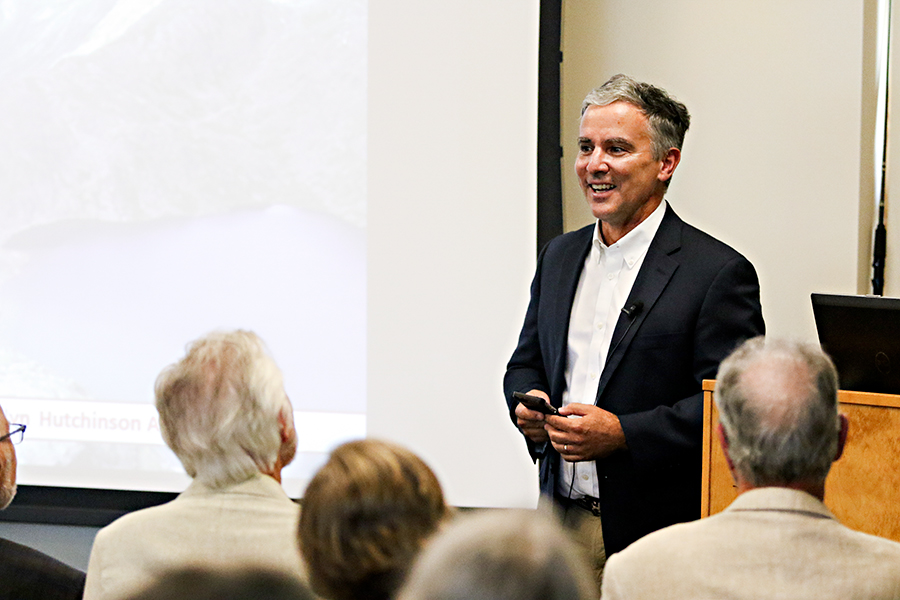Flathead Lake Bio Station Director Elected to National Academy of Sciences
Distinguished scientific organization recognizes Jim Elser’s leadership at one of the most respected research stations in the U.S.
By Tristan Scott
The National Academy of Sciences, one of the most distinguished scientific organizations in the country, has elected Flathead Lake Biological Station Director James Elser in recognition of his distinguished work and research achievements at the 120-year-old research station known as the “Sentinel of the Lake.”
Membership in the National Academy of Sciences (NAS) is one of the highest honors given to a scientist or engineer in the United States. One hundred new members were elected this year, honored for their continuing achievements in original research.
In addition to serving as director of the vaunted research station on Flathead Lake, Elser is a Bierman Professor of Ecology at the University of Montana.
“We are so pleased that the scientific community has recognized Professor Elser as one of our country’s most important scientists,” University of Montana President Seth Bodnar said in a statement issued following the announcement. “The UM family proudly celebrates this well-deserved recognition.”
The NAS is a private, nonprofit institution established under a congressional charter signed by President Abraham Lincoln in 1863. It recognizes achievement in science by election to membership, and – with the National Academy of Engineering and the National Academy of Medicine – provides science, engineering and health policy advice to the federal government and other organizations.
“It is very exciting to join the ranks of the National Academy, as it is the home of so many scientific heroes of the past and present,” Elser said. “I hope that membership in the NAS can help in elevating the importance of protecting precious water resources like Flathead Lake from potential threats from nutrient pollution, invasive species and climate change.”
Elser was elected to NAS by current members of the Academy, and will join them as they advise the nation on matters relating to science, engineering and medicine.
As a scientist, Elser is best known for his role in developing and testing the theory of ecological stoichiometry, which is the study of the balance of energy and chemical elements such as carbon, nitrogen and phosphorus in ecological systems.
As director of the Bio Station, Elser has expanded the station’s freshwater monitoring program, increased community outreach and launched a Flathead Lake Aquatic Research and Education (FLARE) K-12 program that now engages thousands of students each year.
“I have collaborated with so many amazing scientists during my career, including some amazing graduate students and postdocs,” Elser said. “This recognition is really a reflection of my good luck in having such wonderful students and collaborators.”
His current research is focused on Flathead Lake, as well as mountain lakes of western Montana and western China. Elser also works actively in advancing the cause of phosphorus sustainability in the food system to protect water quality.
Though by far the most prestigious recognition Elser has earned, he has also been named a Fellow of the American Association for the Advancement of Science; is an elected foreign member of the Norwegian Academy of Arts and Sciences; and has received the G.E. Hutchinson Award of the Association for the Sciences of Limnology and Oceanography, the world’s largest scientific association dedicated to aquatic sciences. He served as ASLO’s president from 2014 to 2016.
“This is a tremendous accomplishment, one of the very highest honors for an American scientist,” UM Provost Jon Harbor stated in a press release. “We are so proud of Professor Elser and thrilled that University of Montana faculty are yet again recognized among the most highly distinguished researchers in the world.”
Elser is only the second active member of the National Academy of Sciences in the state of Montana.
He accepted the lead position at the Flathead Lake Biological Station in 2015, taking the reins from Jack Stanford, an internationally renowned scientist in his own right who served as director the last 36 years. Stanford started at the University of Montana’s field station along Flathead Lake in 1972 as a doctorate student pursuing stonefly research and became director in 1980. He is credited with shaping the biological station into a world-class research site for freshwater ecology and limnology, the study of inland waters.
Elser and his wife, Monica, came to Montana from the desert landscape of Arizona, where Jim served as regent’s professor at Arizona State University and was a distinguished scientist and scholar. Among his many notable qualifications, Elser was president of the world’s largest water-science society, the Association for the Sciences of Limnology and Oceanography, and has been published in more than 220 scientific journals.
For years, Elser turned down other prestigious positions awaiting the opportunity to work at the Flathead Lake Biological Station, one of the oldest active field stations in the U.S. since its inception in 1899.
Now Elser is here, marking the dawn of a new era for one of the most respected research stations in the nation. Monica Elser serves as the education liaison at the station, where she works to connect communities and the university to the scientific research taking place at Flathead Lake.
For more information about Jim Elser’s research and career, visit the Flathead Lake Biological Station website at flbs.umt.edu.